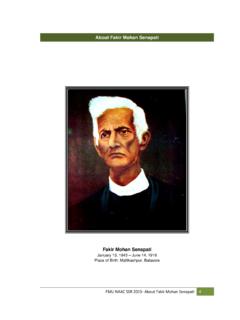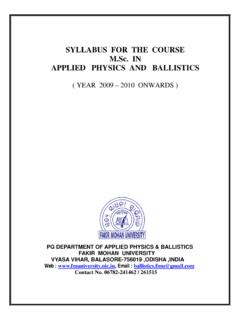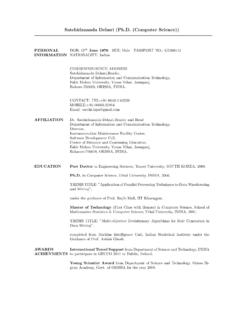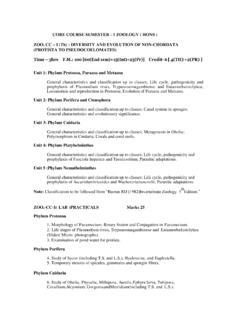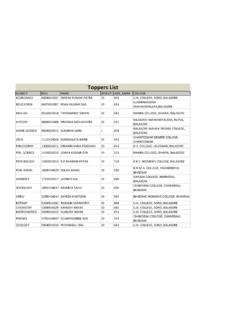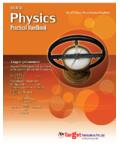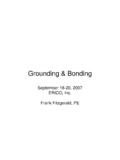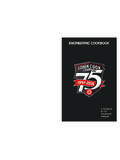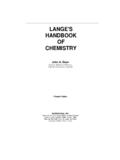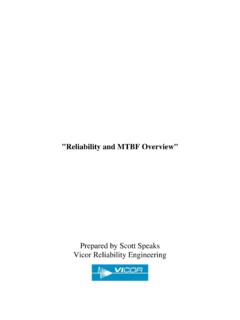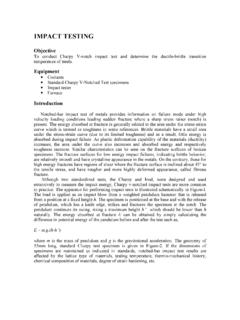Transcription of SYLLABUS FOR THE COURSE M. SC. IN PHYSICS …
1 POST GRADUATION DEPARTMENT OF APPLIED PHYSICS AND. BALLISTICS, F. M. UNIVERSITY, BALASORE. SYLLABUS FOR THE COURSE M. SC. IN. PHYSICS (SFC MODE). 2014 onwards 1. Department of Applied PHYSICS and Ballistics Revised SYLLABUS structure with effective from Dt. Post approved by BOS on Dt. (SFC Mode). in PHYSICS Semester Marks Credit 1st semester 300 24. 2nd semester 300 24. 3rd semester 300* 24. 4th semester 300 24. Total 1200 96. *choice based credit paper is selected by the student of other PG Depts. 2. Department of Applied PHYSICS and Ballistics Revised SYLLABUS structure with effective from Dt. Post approved by BOS on Dt. (SFC MODE). in PHYSICS First Semester Code Name Mark Credit APAB-101 Classical Mechanics 50 04. APAB-102 Mathematical Methods in PHYSICS 50 04. APAB-103 Electronics & Computer 50 04. Programming APAB-104 General Instrumentations 50 04. APAB-105 Practical: Electronics 100 08. Total 300 24. Second Semester Code Name Mark Credit APAB-201 Statistical Mechanics 50 04.
2 APAB-202 Quantum Mechanics 50 04. APAB-203 Fluid Dynamics 50 04. APAB-204 (B) Atomic and Molecular PHYSICS 50 04. APAB-205 Practical: Computational PHYSICS : 100 08. Total 300 24. Third Semester Code Name Mark Credit APAB-301 Solid State PHYSICS 50 04. APAB-302 Electrodynamics 50 04. APAB-303 Nuclear & Particle PHYSICS : 50 04. APAB-304 Modern PHYSICS and Electronics 50 04. APAB-305 Practical: Modern PHYSICS & Material 100 08. Science APAB-306 Fakir Mohan Studies 100(Non Credit) 00 (Non credit paper). Total 400 24. 3. in PHYSICS Fourth Semester (out of 3 special papers 1 special paper is mandatory). Special Paper-II Electronics Special Paper-III Nuclear & Particle PHYSICS Special Paper-IV Condensed matter PHYSICS Special Paper-I (Electronics). Code Name Mark Credit APAB-401(B) Electrical circuit & Control: 50 04. APAB-402(B) Optoelectronics & Optical 50 04. Communication: APAB-403(B) Pulse & Digital circuit: 50 04. APAB-404 (B) Advance electronics practical: 50 04. APAB-405 (B) Project & Grand viva: 100 08.
3 Total 300 24. Special Paper-II (Nuclear and Particle PHYSICS ). Code Name Mark Credit APAB-401(C) Nuclear structure 50 04. APAB-402(C) Nuclear reaction & Nuclear 50 04. Astrophysics APAB-403(C) Particle PHYSICS 50 04. APAB-404 (C) Seminar: 50 04. APAB-405 (C) Project & Grand viva : 100 08. Total 300 24. in PHYSICS Special Paper-III (Condensed Matter PHYSICS ). Code Name Mark Credit APAB-401(D) Condensed Matter PHYSICS -I 50 04. APAB-402(D) Condensed Matter PHYSICS -II 50 04. APAB-403(D) Condensed Matter PHYSICS -III 50 04. APAB-404 (D) Seminar: 50 04. APAB-405 (D) Project & Grand viva : 100 08. Total 300 24. 4. SEMESTER-I. PAPER-APAB-101 Marks: 40. SUB: CLASSICAL MECHANICS Internal Marks: 10. Total Marks: 50. UNIT-I. Survey of the elementary particles: Mechanics of a particle-Mechanics of a system of particles . Constraints-D'Alembert's principle and Lagrange's equations-velocity dependent potentials and the dissipation function, simple applications of the Lagrange formulation.
4 Variational Principle and Lagrange's Equations: Some techniques of the calculus of variations-Derivations of Lagrange's equations-from Hamilton's principle-Extension of Hamilton's principle to nonholonomic systems-Advantages of variational principle formulation-conservation theorems and symmetry properties. UNIT-II. Two body Central force Problems ; Reduction to the equivalent one-body problem-The equations of motion and first integrals-The equivalent one-dimensional problems and classification of orbits-The virial theorem-The differential equation of orbit and integrable power-law potentials-conditions for closed orbits (bertrand's theorem)-The Kepler Problem Inverse square law of force-The motion in time in the Kepler problem-The Laplace-Runge-Lenz vector-Scattering in a central force field, Transformation of the scattering problem to the laboratory co-ordinates. UNIT-III. The Kinematics of Rigid Body Motion: The independent co-ordinates of a rigid body-Orthogonal transformation-Formal properties of the transformation matrix, The Euler Angles, Euler's theorem on the motion of a rigid body-Finite rotations-Infinitesimal rotations-Rate of change of vector-The Coriolis force.
5 UNIT-IV. The Rigid Body Equations of Motion: Angular momentum and kinetic energy of motion about a point-Tensor and dyadics-The inertia tensor and the momentum of inertia-The eigen values of the inertia tensor and the principal axis transformation-Methods of solving rigid body problems and the Euler equations of motion Torque-Free motion of a rigid body-The heavy symmetrical top with one point fixed-Precession of the equinoxes and of satellite orbits-Precession of system of changes in a magnetic field. TEXT BOOKS: 1 Classical Mechanics-Herbert Goldstein, Addison-Wesley/Narosa (Indian Student Edition). 2 Classical Mechanics-Rana and Joag, Tata-McGraw-Hill REFERENCE BOOKS: 1 Classical Mechanics of particles and Rigid body-Kiran C. Gupta, New age Publishers 2 Classical Uppadaya 3 Classical mechanics , Meenakshi prakashan, 1970, New Delhi. 4 Introduction to classical mechanics and , Tata McGrawHill, 1980, New Delhi. 5 An Introduction to Continuum Mechanics-M. E. Gurtin, Academic Press 5.
6 PAPER-APAB-102 Marks: 40. SUB: Mathematical Methods in PHYSICS Internal Marks: 10. Total Marks: 50. UNIT-I. Vector Algebra and Vector Calculus: Differential Operators: Gradient, Divergence and curl, Vector Integration, Gauss Theorem, Stoke's Theorem, Green's Theorem, Curvilinear Co-ordinates, Spherical Polar co-ordinates, cylindrical co-ordinates. LinearAlgebra: Various types of matrices, rank of matrix, Types of linear equation, Linear dependence and independence of vectors, eigen values and eigen vectors, Cayley Hamilton Theorem, Digonalisation of matrices, Elementary ideas about Tensors, Types of tensors, Transformation properties, Introductory group theory, Generators of continuous groups. UNIT-II. Complex Analysis: Complex Algebra, Cauchy-Riemann condition, Cauchy's Integral Theorem, Cauchy's Integral Formula, Taylor's Theorem, Laurent's Theorem, Singularities, Residues, Residue Theorem and Evaluation of Integrals. Fourier Series, Fourier and Laplace Transforms.
7 UNIT-III. Series solution-Frobenous 's differential equation and its solution, Bessel's functions, Recurrence formula, Generating function, Legendre equation and its solution, Legendre's Polynomial, Rodrigue's formula, laguerre's differential equation, Laguerre's functions, Hermite polynomials. UNIT-IV. Wave equation, Heat equation, Possion equation. Theory of Probability: Mean, Median, Mode Dispersion Standard Deviation Binomial, Poisson's and Gaussian Distribution Gauss error curve -Chi-square Test. TEXT BOOKS: 1 Mathematical Methods for Physicist: G. B. Arfken, Hans. J. Weber,-Academic Press 2 Mathematical PHYSICS : H. K. Dass, Rama Verma-S. Chand and Company Ltd. REFERENCE BOOKS: 1 Matrices and tensors: A. W. Joshi 2 Numerical Methods using FORTRAN: C. Xavier-New Age International Publishers 3 Mathematical PHYSICS : B. S. Rajput 4 Mathematical PHYSICS : Satya Prakash 5. Introduction Mathematical PHYSICS : Charlie Harper 6. PAPER-APAB-103 Marks: 40. SUB: Electronics and Computer Programming Internal Marks: 10.
8 Total Marks: 50. UNIT-I. Network Analysis: Node & mesh analysis, Superposition theorem, Thevenin's theorem, Reciprocity theorem, Norton's theorem, Maximum power transfer theorem, Network Analysis using Laplace Transformation: Step response of series RL, RC, RLC, parallel RLC, Response of series RL, RC, RLC, and parallel RLC to exponential driving voltage. UNIT-II. Semiconductor devices : P-N Junction Diode, diodes, Applications of Diode, rectifier circuits, Zener Diode, Transistors: Connections, Transistor as an amplifier, OP-AMP Basics, Virtual Ground, The Ideal Op Amp, Inverting and Non Inverting configurations, Equivalent Circuit model, Op-amp application in Integration, differentiation and Summing Circuits, Differential Amplifier, Voltage Buffer. UNIT-III. Digital Electronics: Number Systems, Binary Arithmetic, Boolean Algebra, Logic Gates, Simplification using Karnaugh map, Combinational Circuits: Adder, Subtractor, Multiplexer, decoder. Sequential Circuits: Flip Flops, Shift Registers, Counters and D/A and A/D Converters.
9 UNIT-IV. Numerical Computing: Programming in C: Constants, variables and data types, Operators and expressions, Input and Output, Decision making and branching, Looping, Arrays Characteristics of numerical computing, Trapezoidal Integration, Simpson's rules for Integration, Runge-Kutta Method and Newton-Raphson method in C . TEXT BOOKS: 1. Network Analysis: Van Valkenburg 2. Network Analysis: Mithal 3. Digital Electronics and Computer Design: M. M. Mano (PHI). 4. Principles of Electronics: Mehta 5. Electronic Devices and Circuit Theory: Boylestad, Nashelsky 6. Let us C:- Yashavant Kanetkar (BPB Publications). 7. C Language and Numerical Mehods C. Xavier 8. Numerical Techniques in C E. Balguruswamy 7. PAPER-APAB-104 Marks: 40. SUB: General Instrumentations Internal Marks: 10. Total Marks: 50. Unit I. Transducers ( Strain Gauges, temperature, pressure/vacuum, magnetic field, vibration, optical, and particle detectors), measurement and control; Signal conditioning and recovery, impedance matching, amplification (Op-amp based, instrumentation amp, feedback), filtering and noise reduction, shielding and grounding; lock-in detector, box-car integrator, modulation techniques.
10 Unit II. Ordnance : Introduction, Classification (Small Arms, Mortar as, Guns, Howitzers, Rocket Launchers, Missiles), Classification based on specific tactical roles, Basic structure, Superstructure, Saddle, Cradle, Requirements of an Ideal Field Gun, Basic components and functional requirements, Certain definitions related to a barrel, Rifling, Rifling design considerations (Forms of twist, Rifling profile), Breech mechanism (breech ring, breech block, thrust surfaces, breech screw, carrier), Extractor, Obturation, Firing mechanism, Chamber. Unit III. Gun Barrel and Design : Desired characteristics of a barrel, Stresses on barrels (Radial stress, Circumferential stress, Longitudinal stress, Torsional stress and Girder stress), Barrel construction (Wire wound, Composite, Mono block), Use of plastic region of the material and its application to auto frettaged method of gun construction, Comparison of different methods of gun construction, Basic gun design rules, Theories of elastic failures, von Misses-Hencky theory of failure including its derivation, Barrel wear (erosion, fatigue, causes and their reduction).
